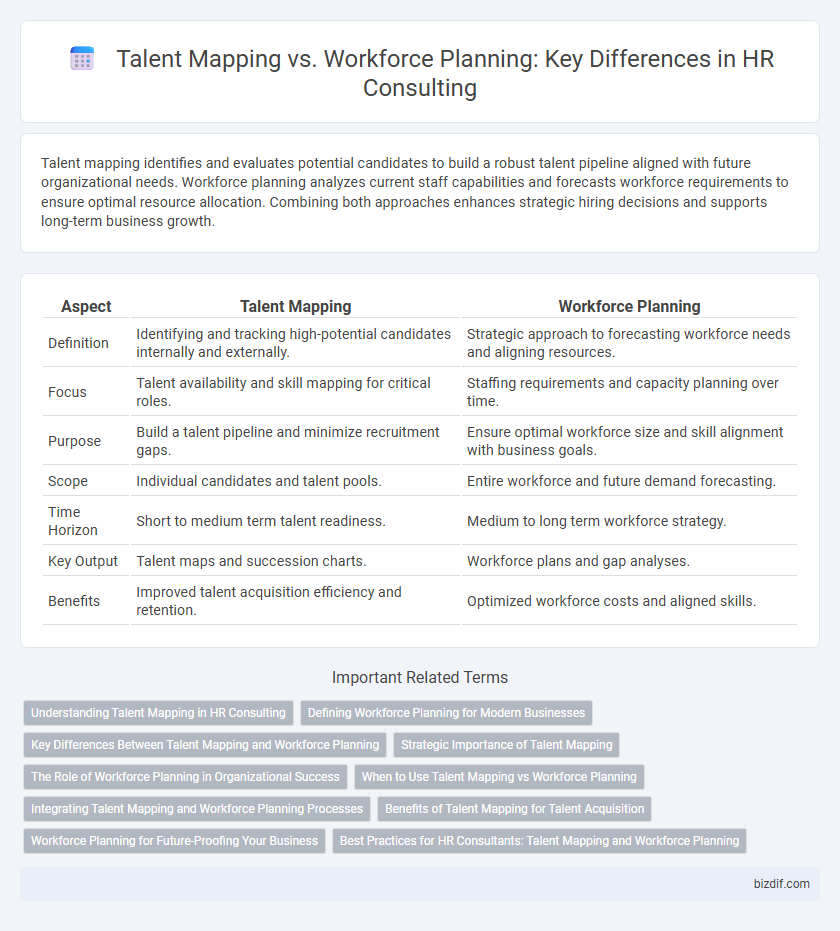Talent mapping identifies and evaluates potential candidates to build a robust talent pipeline aligned with future organizational needs. Workforce planning analyzes current staff capabilities and forecasts workforce requirements to ensure optimal resource allocation. Combining both approaches enhances strategic hiring decisions and supports long-term business growth.
Table of Comparison
| Aspect | Talent Mapping | Workforce Planning |
|---|---|---|
| Definition | Identifying and tracking high-potential candidates internally and externally. | Strategic approach to forecasting workforce needs and aligning resources. |
| Focus | Talent availability and skill mapping for critical roles. | Staffing requirements and capacity planning over time. |
| Purpose | Build a talent pipeline and minimize recruitment gaps. | Ensure optimal workforce size and skill alignment with business goals. |
| Scope | Individual candidates and talent pools. | Entire workforce and future demand forecasting. |
| Time Horizon | Short to medium term talent readiness. | Medium to long term workforce strategy. |
| Key Output | Talent maps and succession charts. | Workforce plans and gap analyses. |
| Benefits | Improved talent acquisition efficiency and retention. | Optimized workforce costs and aligned skills. |
Understanding Talent Mapping in HR Consulting
Talent mapping in HR consulting involves the strategic identification and evaluation of potential candidates both within and outside an organization to create a talent pipeline aligned with future business needs. It provides a detailed insight into skills, competencies, and career aspirations, enabling organizations to proactively address talent gaps before they impact productivity. Unlike workforce planning, which forecasts labor demand and supply, talent mapping delivers actionable intelligence for targeted recruitment and succession planning.
Defining Workforce Planning for Modern Businesses
Workforce planning for modern businesses involves strategically forecasting future talent needs based on organizational goals, market trends, and skill gaps to ensure optimal staffing levels. Talent mapping complements this process by identifying high-potential candidates within and outside the organization, facilitating targeted recruitment and succession planning. Together, workforce planning and talent mapping enable proactive decision-making that aligns human capital with evolving business demands.
Key Differences Between Talent Mapping and Workforce Planning
Talent mapping focuses on identifying and analyzing high-potential candidates within and outside the organization to build a talent pipeline, whereas workforce planning emphasizes aligning current and future workforce needs with business goals through strategic resource allocation. Talent mapping provides insights into talent availability and succession readiness, while workforce planning addresses broader organizational demands, including skills inventory, labor market trends, and capacity forecasting. Both approaches support talent management but differ in scope, with talent mapping being more candidate-centric and workforce planning adopting a holistic organizational perspective.
Strategic Importance of Talent Mapping
Talent mapping provides a strategic advantage by identifying key skill gaps and future leadership potential within an organization, enabling targeted talent acquisition and development. It offers comprehensive insights into competitor talent pools and market trends, ensuring proactive workforce alignment with long-term business goals. Unlike workforce planning, talent mapping drives strategic decision-making by prioritizing high-value roles and critical talent pipelines.
The Role of Workforce Planning in Organizational Success
Workforce planning plays a critical role in organizational success by aligning talent needs with strategic business goals to ensure optimal resource allocation. Unlike talent mapping, which identifies potential candidates for future roles, workforce planning proactively forecasts labor demands and prepares the workforce for changing market conditions. Effective workforce planning enhances productivity, reduces hiring costs, and strengthens a company's competitive advantage through sustainable talent management.
When to Use Talent Mapping vs Workforce Planning
Talent mapping is essential when organizations need to identify and strategically assess high-potential candidates for future roles, especially during talent shortages or leadership transitions. Workforce planning becomes critical in scenarios involving long-term organizational growth, restructuring, or adapting to market changes to ensure the right number and types of employees are available. Choosing talent mapping is optimal for targeted talent acquisition and succession planning, while workforce planning addresses broader workforce capacity and skill alignment challenges.
Integrating Talent Mapping and Workforce Planning Processes
Integrating talent mapping with workforce planning enhances organizational agility by providing a comprehensive view of current capabilities and future talent needs. Talent mapping identifies high-potential candidates and skill gaps, while workforce planning aligns these insights with strategic business objectives and resource allocation. This combined approach enables precise talent acquisition, succession planning, and optimized workforce deployment to meet evolving market demands.
Benefits of Talent Mapping for Talent Acquisition
Talent mapping enhances talent acquisition by providing a strategic overview of potential candidates, enabling precise identification of skill gaps and future hiring needs. It supports proactive recruitment efforts by building a pipeline of qualified candidates, reducing time-to-hire and improving quality of hire. This approach aligns closely with organizational goals, ensuring the acquisition of top talent that drives business growth and competitive advantage.
Workforce Planning for Future-Proofing Your Business
Workforce planning strategically aligns an organization's human capital needs with its long-term business objectives, ensuring the right talent is available to meet future demands. Unlike talent mapping, which identifies and tracks potential candidates, workforce planning encompasses forecasting skill requirements, assessing current workforce capabilities, and developing action plans to address gaps. Effective workforce planning mitigates risks related to talent shortages, enhances organizational agility, and supports sustainable growth in an evolving market landscape.
Best Practices for HR Consultants: Talent Mapping and Workforce Planning
HR consultants enhance organizational talent strategies by integrating talent mapping and workforce planning to identify skill gaps and forecast future workforce needs accurately. Employing data analytics and real-time labor market insights ensures precise talent mapping, while scenario-based workforce planning aligns human capital with business goals. Best practices include continuous stakeholder engagement and leveraging predictive modeling to adapt to dynamic market conditions effectively.
talent mapping vs workforce planning Infographic

 bizdif.com
bizdif.com